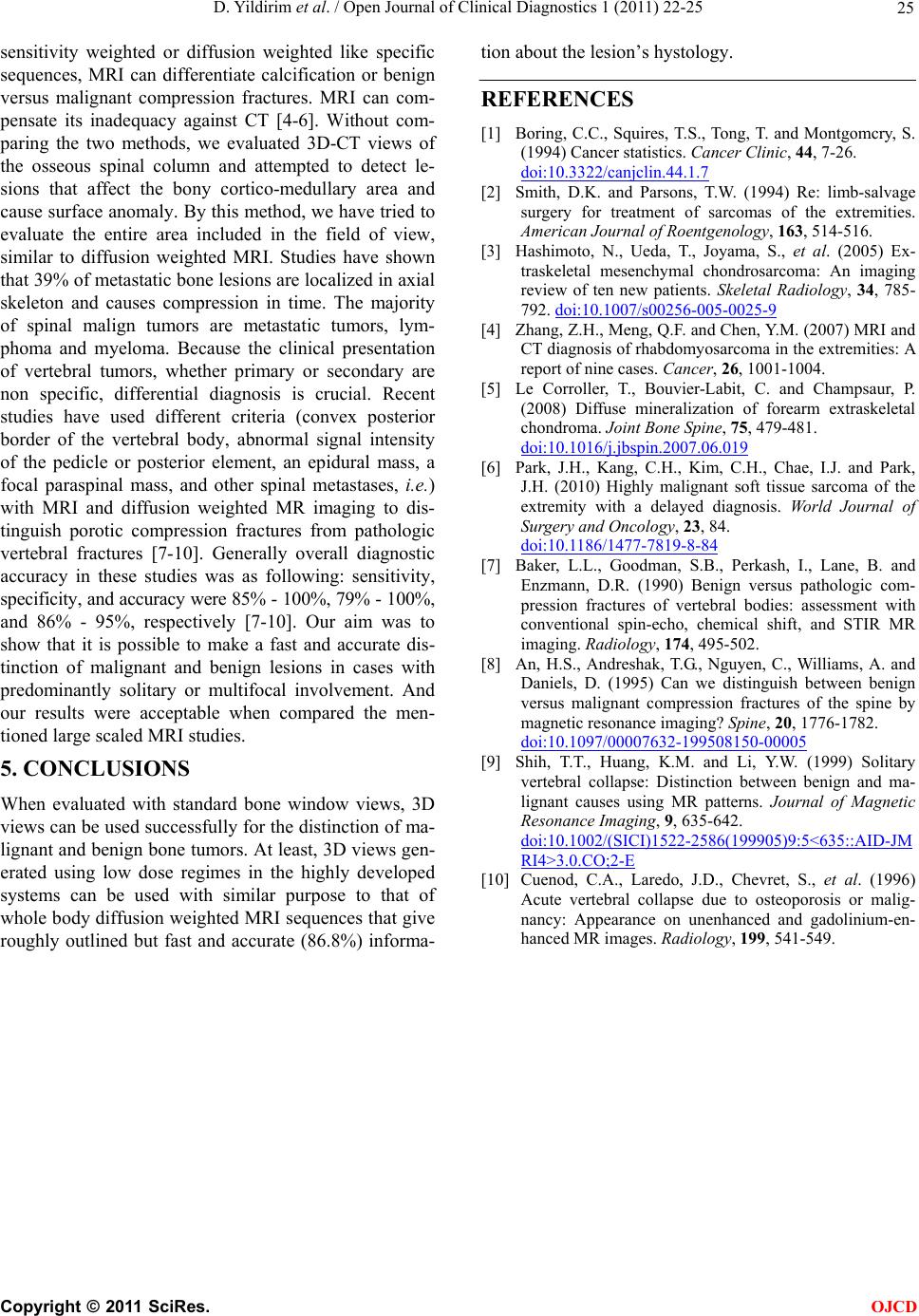
D. Yildirim et al. / Open Journal of Clinical Diagnostics 1 (2011) 22-25 25
sensitivity weighted or diffusion weighted like specific
sequences, MRI can differentiate calcification or benign
versus malignant compression fractures. MRI can com-
pensate its inadequacy against CT [4-6]. Without com-
paring the two methods, we evaluated 3D-CT views of
the osseous spinal column and attempted to detect le-
sions that affect the bony cortico-medullary area and
cause surface anomaly. By this method, we have tried to
evaluate the entire area included in the field of view,
similar to diffusion weighted MRI. Studies have shown
that 39% of metastatic bone lesions are localized in axial
skeleton and causes compression in time. The majority
of spinal malign tumors are metastatic tumors, lym-
phoma and myeloma. Because the clinical presentation
of vertebral tumors, whether primary or secondary are
non specific, differential diagnosis is crucial. Recent
studies have used different criteria (convex posterior
border of the vertebral body, abnormal signal intensity
of the pedicle or posterior element, an epidural mass, a
focal paraspinal mass, and other spinal metastases, i.e.)
with MRI and diffusion weighted MR imaging to dis-
tinguish porotic compression fractures from pathologic
vertebral fractures [7-10]. Generally overall diagnostic
accuracy in these studies was as following: sensitivity,
specificity, and accuracy were 85% - 100%, 79% - 100%,
and 86% - 95%, respectively [7-10]. Our aim was to
show that it is possible to make a fast and accurate dis-
tinction of malignant and benign lesions in cases with
predominantly solitary or multifocal involvement. And
our results were acceptable when compared the men-
tioned large scaled MRI studies.
5. CONCLUSIONS
When evaluated with standard bone window views, 3D
views can be used successfully for the distinction of ma-
lignant and benign bone tumors. At least, 3D views gen-
erated using low dose regimes in the highly developed
systems can be used with similar purpose to that of
whole body diffusion weighted MRI sequences that give
roughly outlined but fast and accurate (86.8%) informa-
tion about the lesion’s hystology.
REFERENCES
[1] Boring, C.C., Squires, T.S., Tong, T. and Montgomcry, S.
(1994) Cancer statistics. Cancer Clin ic, 44, 7-26.
doi:10.3322/canjclin.44.1.7
[2] Smith, D.K. and Parsons, T.W. (1994) Re: limb-salvage
surgery for treatment of sarcomas of the extremities.
American Journal of Roentgenology, 163, 514-516.
[3] Hashimoto, N., Ueda, T., Joyama, S., et al. (2005) Ex-
traskeletal mesenchymal chondrosarcoma: An imaging
review of ten new patients. Skeletal Radiology, 34, 785-
792. doi:10.1007/s00256-005-0025-9
[4] Zhang, Z.H., Meng, Q.F. and Chen, Y.M. (2007) MRI and
CT diagnosis of rhabdomyosarcoma in the extremities: A
report of nine cases. Cancer, 26, 1001-1004.
[5] Le Corroller, T., Bouvier-Labit, C. and Champsaur, P.
(2008) Diffuse mineralization of forearm extraskeletal
chondroma. Joint Bone Spine, 75, 479-481.
doi:10.1016/j.jbspin.2007.06.019
[6] Park, J.H., Kang, C.H., Kim, C.H., Chae, I.J. and Park,
J.H. (2010) Highly malignant soft tissue sarcoma of the
extremity with a delayed diagnosis. World Journal of
Surgery and Oncology, 23, 84.
doi:10.1186/1477-7819-8-84
[7] Baker, L.L., Goodman, S.B., Perkash, I., Lane, B. and
Enzmann, D.R. (1990) Benign versus pathologic com-
pression fractures of vertebral bodies: assessment with
conventional spin-echo, chemical shift, and STIR MR
imaging. Radiology, 174, 495-502.
[8] An, H.S., Andreshak, T.G., Nguyen, C., Williams, A. and
Daniels, D. (1995) Can we distinguish between benign
versus malignant compression fractures of the spine by
magnetic resonance imaging? Spine, 20, 1776-1782.
doi:10.1097/00007632-199508150-00005
[9] Shih, T.T., Huang, K.M. and Li, Y.W. (1999) Solitary
vertebral collapse: Distinction between benign and ma-
lignant causes using MR patterns. Journal of Magnetic
Resonance Imaging, 9, 635-642.
doi:10.1002/(SICI)1522-2586(199905)9:5<635::AID-JM
RI4>3.0.CO;2-E
[10] Cuenod, C.A., Laredo, J.D., Chevret, S., et al. (1996)
Acute vertebral collapse due to osteoporosis or malig-
nancy: Appearance on unenhanced and gadolinium-en-
hanced MR images. Radiology, 199, 541-549.
C
opyright © 2011 SciRes. OJCD